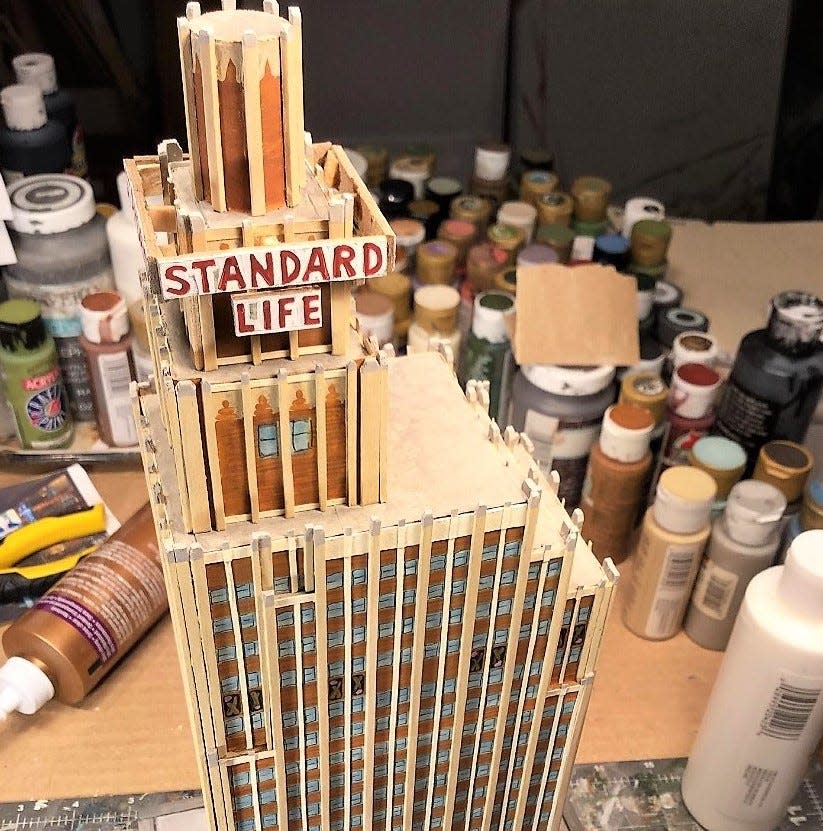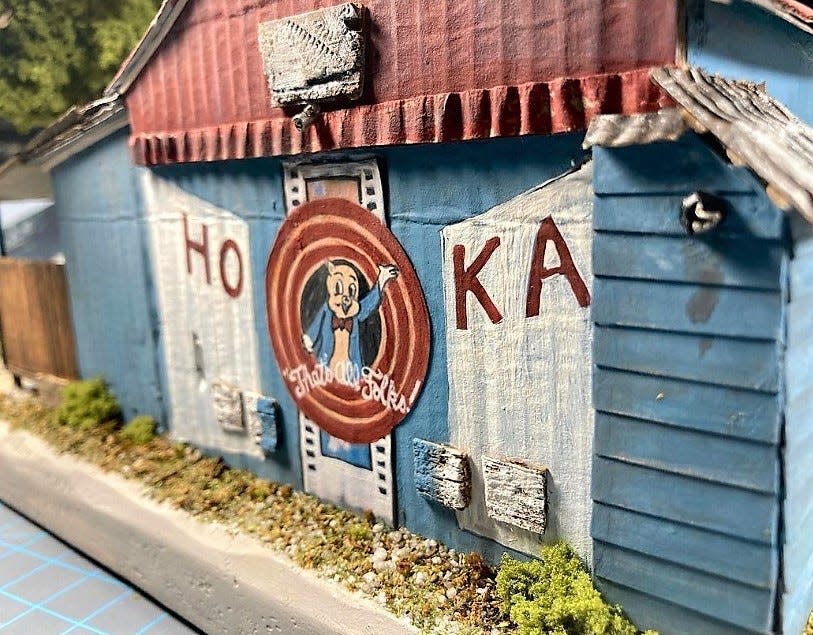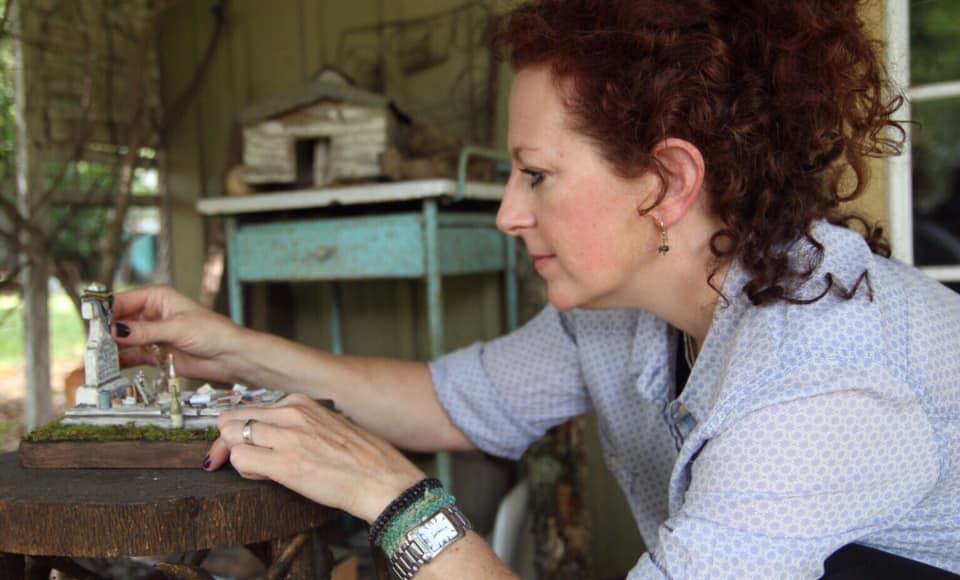See the detail in the miniature replicas created by Oxford artist Lee Harper
The Hoka, a fabled movie theater, eatery and nightspot that was once a favorite gathering place for college students in Oxford, is known as a place that spawned legends.
Cobbled inside an old cotton warehouse by its bohemian owner Ron Shapiro, The Hoka was famous for slogans including, “No Shoes, No Shirt, Who Cares?” and “Sorry, We’re Open.” For two decades it was known for everything from freshly baked bagels to late night blues shows to eccentric independent films. Nearly every student attending the University of Mississippi between 1976 and 1996 has at least one memorable Hoka story to tell.
And though the theater is long gone (Shapiro died in 2019), its memory continues to spawn new legends and success stories. One of the latest Oxford residents to take inspiration from the unlikely establishment is an artist named Lee Harper.
Harper’s distinctive miniature replications of Mississippi buildings, made from paper, wood, wire and other materials, have earned her praise and lucrative job offers from throughout the state, including a recent commission from the Walter Anderson Museum of Art in Ocean Springs.

A native of Meridian, Harper studied English and philosophy at the University of Southern Mississippi and spent some time in Jackson before relocating with her husband, Andy, to the Oxford area several years ago. Whether it was painting pictures or building a wooden deck outside their home, Harper said she has always enjoyed working with her hands. “I have always been a maker,” she said.
After college, Harper said she also “became a huge history nerd.” So, after hearing about the Hoka’s storied past from Oxford friends, she hit on a unique idea in 2019.
The local Yoknapatawpha Arts Council was holding its annual “Ornament Auction” that December as a fundraiser. Realizing the memories that the theater held for many people, Harper decided to create “a little bitty Hoka” as her donation for the auction.
It wasn’t technically her first miniature project. In 2017 she began a series of “History of Bones” sculptures featuring tiny skeleton figures in settings that focus on obscure history, customs and culture. But Harper says it was the tiny Hoka model that really set her career into high gear. “As soon as I made that piece people started coming to me,” Harper said.
“The Hoka set the record for our highest selling ornament — not just for that year, but in our whole history of selling ornaments,” said Arts Council President Wayne Andrews. The ornament auction, which is held annually, is the longest running fundraiser in the council’s 50-year history, he said.
People from Oxford and from throughout the state soon began asking Harper to create their own historic homes and buildings as tiny models. Since then she has completed between 30 and 40 tiny buildings at her home studio located several miles outside of Oxford.

“I thrive working by myself. You get lost in the little things. It is so much fun,” Harper said. Even during the COVID-19 pandemic when many people complained of being forced inside, Harper says, “I got so much work done.”
Several of Harper’s commissions have been for buildings in Jackson and the central Mississippi area. Among them have been replications of the Medgar Evers home, the Standard Life Building, the Blue Front Cafe in Bentonia, and most recently the iconic Mayflower Cafe on Capitol Street.
“The Mayflower was one of my favorite projects,” Harper said. Originally the idea was to create just the outside of the building. “Then I thought how much fun it would be to turn on the lights and really see inside,” she said.
After taking photos of the interior as well as searching the internet for any vintage photos she could find, Harper created a faithful replica of the restaurant’s dining room — right down to the leather covered booths, vintage coat and hat racks, mounted fish on the walls, and even tiny bottles of “comeback” sauce on the tables. Harper says no detail is too small or inconsequential to recreate. The project took approximately three months to complete.Harper’s newest and largest project to date has been to create a replica of “Oldfields,” the longtime former home of celebrated watercolor artist and printmaker Walter Anderson who lived on the Gulf Coast.

Creating each piece requires research, Harper says, and the Oldfields project presented a unique set of challenges.Like the Mayflower project, museum officials wanted the Anderson house to be detailed as much as possible — right down to furnishings that would have existed in the 1940s.
The trouble was that while she was able to locate exterior photos of the home from that time (as well as a couple of photos from the attic where Anderson was known to work) no photos existed of other interior rooms. And though the home is still standing, Hurricane Katrina in 2005 caused extensive damage, leaving few clues behind as to what used to be inside.
To fill in the blanks, Harper turned to Anderson’s children who grew up there. “They didn’t expect to remember very much at first but surprisingly they remembered a ton,” she said. Harper also toured the home, which is located in Gautier, taking photos and making measurements in order to keep everything in the model to proper scale.The resulting miniature replication, created in polychromed wood, opened during a reception at the museum on June 8.
“We are extremely pleased with the result,” said Julian Rankin, Executive Director of the Anderson Museum. “Lee put an amazing amount of time into it. Everything is hyper-detailed where visitors can actually see the bedrooms and the workshop where Walter did much of his work — particularly his block prints.”
Visitors to the exhibit can use a kiosk next to the model to learn more about each room and the items depicted. Although Oldfields remains in disarray the property has recently been purchased by the Mississippi Heritage Trust which is securing a grant with plans to restore the structure. “It has been on the most endangered list of historic properties for a long time,” Rankin said.
The Return to Oldfields exhibit, made possible with funding from The Hearin-Chandler Foundation and the Mississippi Coast National Heritage Area through the Mississippi Department of Marine Resources, will continue at the museum through September 23.
The majority of Harper’s other works have been sold to private collectors and thus far there have been no public exhibitions featuring a wide cross section of them. But people interested can purchase her first book called “Tiny Oxford” featuring detailed photos of her creations from around that area. Harper says she eventually wants to also publish a “Tiny Mississippi” gift book featuring her work from other areas around the state.
Harper’s book is available at Lemuria Books in Jackson and at Square Books in Oxford. It may also be ordered through her website: tinyhistorystudios.com
This article originally appeared on Mississippi Clarion Ledger: Oxford artist creates miniature models of Mississippi landmarks

